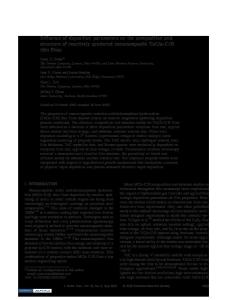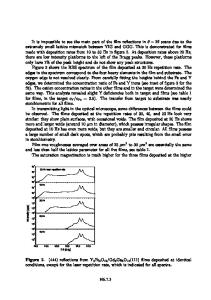The influence of composition and thermomechanical condition on mechanical properties of TaC and TaB strengthened chromiu
- PDF / 632,968 Bytes
- 5 Pages / 612 x 783.28 pts Page_size
- 107 Downloads / 331 Views
RESULTS AND DISCUSSION Study Materials Nominal and analyzed compositions of the study alloys are given in Table I. Included in the table are data for two alloys prepared on other work whose mechanical properties are used in this paper. Chemical analysis revealed Ta, C, and B levels in all compositions to be within • at. pet of the nominal amounts. Oxygen and nitrogen contamination were maintained at or below 0.10 and 0.02 at. pct. Residual yttrium levels ranged from 0.18 to 0.03 at. pct. This element was added to deoxidize the melts. An inverse relationship between oxygen and yttrium levels is apparent in the data. Note that information on actual phase formation and stability in the study compositions is limited. What is available indicates that the likely stable carbide and
Melting, F a b r i c a t i o n , and E v a l u a t i o n The p r o c e d u r e s used to p r e p a r e and evaluate m a t e r i a l w e r e i d e n t i c a l to those r e p o r t e d p r e v i o u s l y , z'2 In b r i e f , e x p e r i m e n t a l c o m p o s i t i o n s were i n d u c t i o n m e l t e d as 10 lb (4.5 kg) ingots and r e d u c e d 96 pct to 3/8 in. (0.95 cm) t e s t rod by e x t r u s i o n and swaging at 2100~F (1422 K). Strength was e v a l u a t e d by v a c u u m s t r e s s - r u p t u r e and t e n s i l e t e s t i n g at 2100~ (1422 K), while a i r e n v i r o n m e n t t e n s i l e t e s t s w e r e u s e d to determine ductile-to-brittle transition temperatures, T e s t s w e r e r u n on wrought ( a s - f a b r i c a t e d ) , r e c r y s t a l lized, and s o l u t i o n a n n e a l e d and aged m a t e r i a l . Specific c o n d i t i o n s for heat t r e a t m e n t wege e s t a b l i s h e d by phase s t a b i l i t y , m i c r o s t r u c t u r e , and h a r d n e s s s t u d i e s , z-4 S t r e n g t h e n i n g phase p r e c i p i t a t i o n was e v a l u a t e d by e l e c t r o n m i c r o s c o p y and f r o m c r y s t a l lographic data. A. M. FILIPPI, is Senior Engineer, WestinghouseElectric Corporation, Astronuclear Laboratory, Pittsburgh, PA 15236. Manuscript submitted November 9, 1973. METALLURGICALTRANSACTIONS
Table I. Chemical Analysis of the Study Alloys
NominalComposition MolePct Cr-0.25TaC2 Cr-0.50TaC1. Cr-0.75TaC Cr-I.00TaC Cr-0.50TaBt Cr-075TAB Cr-1.00TAB Cr-0.25,TaC-0.25TaB**
AnalyzedComposition At. Pct Cr-0.27Ta-0.28C Cr-0.44Ta-0.53C Cr-0.78Ta-0.77C Cr-I.02Ta-I.14C Cr-0.54Ta-0.49B Cr-0.83Ta-0.69B Cr-l.06Ta-0.99B Cr-0.52Ta-0.33C-0.25B
ImpurityContent At. Pct 0 N Y 0.062 0.049 0.101 0.009 0.040 0.046 0.077 0.006
0.021 0.024 0.009 0.008 0.009 0.008 0.008 0.024
0.05 0.08 0.03 0.17 0.12 0.10 0.I 1 0.18
*TaGis the carbidephasestablein thiscompositionto above2200~ (1477K) ' tA mixedmetalborideof probablyTa2CrB2 formulais stablein this composition to above2500~ (1644K).3 **Aphaseextractionobtainedfroma sampleequilibratedat 2100~ (1422K) for over200 h wasidentifiedby X-raydiffractionas consistingof TaC and Ta2CrB2.4 VOLUME 5, JUNE 1974-1423
(a) Table II. Tensile Properties of the Study Allo
Data Loading...










